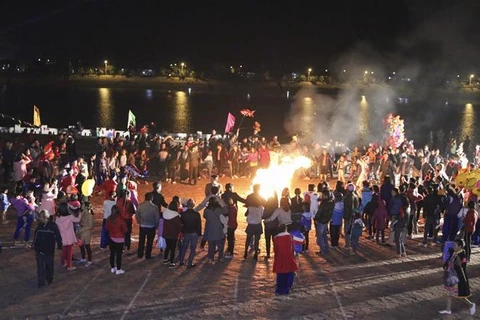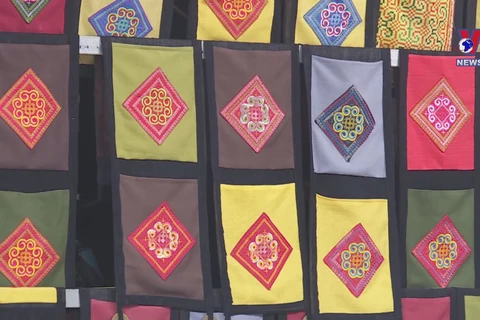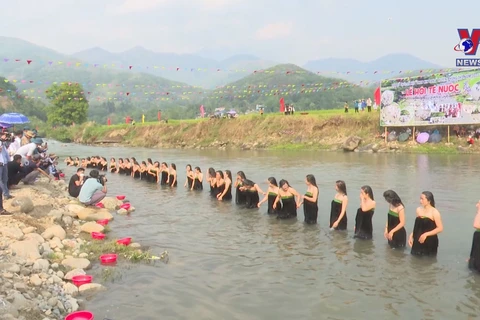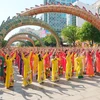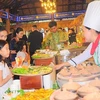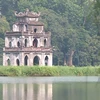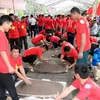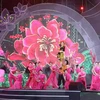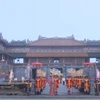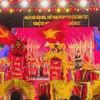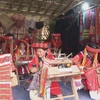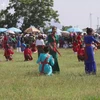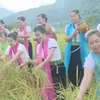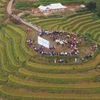Hanoi (VNA) - The Ap Ho Chieng festival has been reenacted in Phong Tho district of the northern province of Lai Chau since 2014. This is the first year it has formed part of the Then Kin Pang festival.
A highlight of the Ap Ho Chieng festival each year is the scene of beautiful women of White Thai ethnic minority group as they wash their hair together on the last day of the Lunar New Year. It was reenacted at Nam Lum spring in Khong Lao commune, Phong Tho district of Lai Chau.
For Thai ethnic people in Muong So area in Khong Lao, the festival holds significant meaning in their spiritual lives. It is a unique cultural value reflecting local solidarity and people’s connection with nature.
The festival has links to Lady Han who dressed as a man to fight invaders and returned triumphantly on the last day of the Lunar New Year. She and the soldiers rested and washed themselves along the Nam Bo riverbank of Nam Lum spring to celebrate their victory and the New Year. The sky where she bathed suddenly sparkled as five-coloured clouds appeared and brought her to Heaven.
To express gratitude, local people set up a shrine dedicated to her. Thus began the ritual to wash hair on the last day of the Lunar New Year for her protection and the blessing of good health, love and happiness, and safety for the villagers and bountiful crops.
Thai people believe that those who have yet to wash their hair on the last day of the lunar year cannot escape the ill fortunes of the passing year. They may follow them into the New Year.
Therefore, when a lunar year comes close to its end, all villagers need to wash their hair to wash away hardships, bad luck and unfortunate things of the previous year. They rely on the hot water of the wash to get rid of accidents and diseases.
At the same time, local people wish for a safe, lucky and prosperous new year. Washing hair in the new year reflects people’s belief in deities and good fortune. It is a traditional cultural trait of White Thai ethnic minority group in the northwestern region in general and Phong Tho district in particular.
The festival comprises four parts. After rituals, a procession will move to Nam Lum spring to offer tribute to land and river deities, voicing a wish for happiness.
Afterwards, 30 young girls from the Thai ethnic group will splash soapberry water to ward off evil spirits and begin washing their hair as local villagers and visitors to the area look on.
On one day of the festival, villagers will travel to Lady Han shrine to take water there back to their home to ask for safety. They will be accompanied by the sound of drums and gongs to ward off evil spirits so that everyone will be safe to join the New Year celebration.
During the festival, people also pay tribute to the gods of mountain and river and express their gratitude to the deities for protecting them in the past year.
Before washing, young girls of Thai ethnic group will rub fragrant leaves into their hair in honour of Lady Han.
The chosen girls are the most beautiful ones in the village. After the rituals, they will wear traditional dress and line up in the spring to start washing their hair. At first, strands of beautiful long black hair will be seen falling down. When signaled, all the girls will flip their hair upward at the same time.
To ensure a smooth-sailing festival, the girls must take good care of their hair for many weeks prior to the event. They wash their hair with soapberry, rice water and petals of wildflowers. This helps them maintain their long, silky, and shiny black hair.
Ma Thi Thao, who is a resident of Khong Lao commune, said this is the first time that she has participated in the festival. She feels proud that a traditional trait of the Thai ethnic group is not lost, hoping that the festival becomes a favourite for tourists.
Holding the same view, Hoang Thi Tuyen from Hanoi capital city recognized how fortunate she is for getting the chance to attend the festival. The event highlights the beauty and elegance of the women in the Thai ethnic group.
The Ap Ho Chieng festival contains the love of local people for their hometown and respect to ancient customs. This is coupled with the links between humans, nature, and the collective village traditions of the past./.


